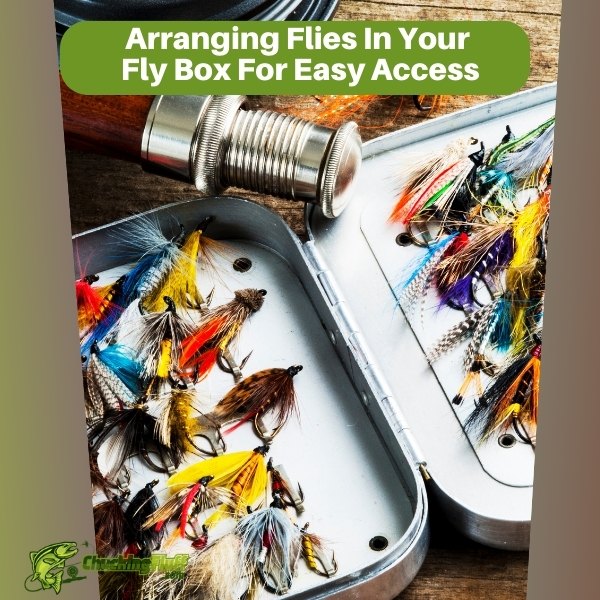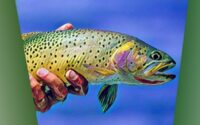| Disclosure: Just to be open and honest the buttons and links you click on in the website will in most cases take you to another website where you can purchase the products I am reviewing. As an Amazon Associate I earn from qualifying purchases. |
Arranging Flies In Your Fly Box For Easy Access

Picture this: you’re knee-deep in a rushing river, the sun is glinting off the water, and a trout is rising just upstream. You know the perfect fly for this situation, but where is it? Rummaging through a chaotic jumble of feathers and hooks in your fly box can quickly kill the moment and spook the fish. That’s where a well-organized fly box comes in. It’s not just about neatness; it’s about maximizing your time on the water and increasing your chances of success.
Quick Post Navigation
The Fly Fishing Fly Box: A World of Organization
Fly boxes are more than just containers; they’re essential tools for any angler. They protect your precious flies, keep them organized, and allow for quick and easy access when you need them most.
Why Bother Organizing?
Think of your fly box as your on-the-go tackle shop. Just like you wouldn’t want to shop in a store where everything is thrown haphazardly on the shelves, you don’t want to waste precious fishing time searching for the right fly. A well-organized fly box allows you to:
- Quickly identify and select the fly you need.
- Prevent tangles and damage to your flies.
- Maximize your fishing time.
- Stay focused on the water and the fish.
Types of Fly Boxes: Finding Your Perfect Fit
Fly boxes come in a dizzying array of shapes, sizes, and materials. Choosing the right one for your needs can be a bit overwhelming. Let’s break down some of the most common types:
Compartmentalized Boxes
These boxes feature multiple compartments of various sizes, perfect for separating different types of flies, like dry flies, nymphs, and streamers. They’re great for anglers who like to categorize their flies meticulously.
Foam Boxes
Foam boxes have a sheet of foam with slits for holding flies. They’re simple, affordable, and offer a good grip on your flies. However, they can be bulkier than other types and may not be ideal for delicate flies.
Magnetic Boxes
Magnetic boxes use magnets to hold flies securely in place. They’re sleek, compact, and offer excellent visibility of your flies. However, they can be more expensive than other options.
Considerations for Saltwater vs. Freshwater
If you’re a saltwater angler, look for boxes made from corrosion-resistant materials like aluminum or plastic. Saltwater can quickly wreak havoc on metal components.
Arranging Your Flies: Tried and True Methods
Now that you have your fly box, it’s time to tackle the real challenge: arranging your flies. Here are some popular methods:
By Size and Type
This is perhaps the most common method. Separate your flies by type (dry flies, nymphs, streamers, etc.) and then further organize them by size within each category.
Dry Flies, Nymphs, Streamers, and More
- Dry Flies: Arrange by size and style (e.g., mayflies, caddisflies, terrestrials).
- Nymphs: Organize by size, pattern, and weight.
- Streamers: Group by size, color, and profile.
- Saltwater Flies: Separate by species targeted (e.g., bonefish, tarpon, permit).
By Color
Organizing by color can be helpful when you know the general color of the fly you’re looking for but can’t quite remember the specific pattern.
By Frequency of Use
Keep your most frequently used flies in the most accessible part of your box. This will save you time and frustration on the water.
By Water Type
If you fish in different types of water (e.g., stillwater vs. rivers), consider dedicating separate sections of your box to flies specific to each environment.
Stillwater vs. Rivers and Streams
- Stillwater: Focus on flies that imitate insects found in lakes and ponds (e.g., chironomids, damselflies).
- Rivers and Streams: Prioritize flies that imitate insects found in moving water (e.g., mayflies, caddisflies, stoneflies).
Labeling and Indexing: Taking Organization to the Next Level
For the truly organized angler, labeling and indexing your fly box can be a game-changer.
Waterproof Labels and Markers
Use waterproof labels or markers to identify different sections of your box. This will help you quickly locate the flies you need, even in wet conditions.
Creating a Fly Box Index
Consider creating a simple index card or spreadsheet that lists the contents of your fly box. This can be especially helpful if you have multiple boxes or a large collection of flies.
Maintaining Your Fly Box: Tips for Longevity
Your fly box is an investment, so it’s important to take care of it.
Keeping it Dry
Moisture is the enemy of flies and fly boxes. Make sure to dry your box thoroughly after each use, especially if you’ve been fishing in saltwater.
Preventing Rust
Rust can quickly ruin your flies and your fly box. Consider using a desiccant packet or silica gel to absorb moisture and prevent rust.
Beyond the Basics: Advanced Fly Box Hacks
Want to take your fly box organization to the next level? Here are a few creative hacks:
Using Silicone Inserts
Silicone inserts can be cut to fit your fly box compartments and provide extra grip for your flies. They’re also great for preventing rust.
Repurposing Craft Supplies
Don’t be afraid to get creative! Craft stores offer a wealth of organizational tools that can be repurposed for your fly box, such as bead organizers, small containers, and dividers.
Conclusion
A well-organized fly box is an indispensable tool for any fly angler. It saves time, prevents frustration, and allows you to focus on what really matters: enjoying your time on the water and catching fish. By implementing the tips and techniques outlined in this article, you can transform your fly box from a chaotic mess into a streamlined system for fly fishing success.
FAQs
1. What’s the best way to store my fly box when not in use?
Store your fly box in a cool, dry place away from direct sunlight. Avoid storing it in humid environments or where it might be exposed to extreme temperatures.
2. How do I clean my fly box?
You can clean your fly box with a mild soap and water solution. Be sure to rinse it thoroughly and dry it completely before storing it.
3. Can I use a fly box for storing other fishing tackle?
While fly boxes are primarily designed for flies, they can also be used to store other small fishing tackle, such as hooks, beads, and split shot.
4. What’s the best way to prevent my flies from getting crushed in my fly box?
Choose a fly box with adequate spacing between the flies. You can also use foam inserts or other dividers to create extra protection.
5. How often should I reorganize my fly box?
It’s a good idea to reorganize your fly box at least once a season, or more often if you fish frequently. This will help you ensure that your flies are in good condition and easily accessible.


